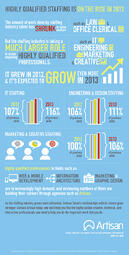Infographics have long been used to convey a large amount of information in a brief amount of time. This is their specialty, and they’re darn good at it.
Over the years, infographics have been used by brands to spread their appeal far and wide to casual followers who might otherwise not take the time to sit and read the information presented to them. But 2014 seems to be a year of change for the use of infographics as an increasing number of companies look to the interactive infographic to extend their reach even further across the vast distances of cyberspace.
What is an Interactive Infographic, Anyway?
Infographics aren’t new. Businesses and brands have been using them for a long time to tell their stories in an engaging manner that doesn’t require a viewer to commit themselves to reading an entire article filled with data, stats, and cleverly placed calls to action. But the concept of the interactive infographic is one that’s still relatively young. The difference between a traditional infographic and an interactive infographic is in the added use of animation and navigational arrows that let you “browse” through it like you would a website. Historically, interactive infographics have been difficult to make. But that has changed recently.
Improved Technologies Imbue Infographics with Deeper Dimension
Up until recently, the ability of most companies to produce and distribute interactive infographics has been limited. Mostly, this was due to a preponderance of web browsers that didn’t support CSS3 and HTML5, which are key components that make interactive infographics really fly. Nowadays, that’s not a big issue, since the major browsers all support the ability to encode impressive animation. This has also brought about a revolution in the ability for smaller companies and brands with limited budgets to be able to pull off impressive infographics that don’t cost an arm and a leg to program and design. Yet another benefit of the advancement of these technologies makes it possible for interactive infographics to render on a wide variety of screen sizes – enabling mobile users to enjoy them too.
Why Everyone is Crazy for Infographics
It’s no secret that infographics are insanely popular among information hungry web surfers. Not only are they easy on the eyes if they’re artfully approached and designed, but they’re also a media that has been found to be incredibly sharable across a multitude of social media platforms. In other words, you get a lot more play out of an infographic than you do a standard article. Why? Because for the most part, people’s brains process information a lot easier when they’re fed visual information. The impact is more immediate and therefore more impactful.
The Value of Interactive Infographics for Business
Businesses are constantly trying to communicate what they do to others. Whether that’s to other businesses in B2B marketing, or directly through the B2C pipeline. Using an infographic can be greatly effective at presenting otherwise boring “About Us” and “What We Do” information in a way that’s not only highly readable, but that’s also entertaining. Adding a third dimension of interactive data to infographics can effect dramatic change with regard to getting the word out about a company’s goods and services – which ultimately results in boosted sales.
Design professionals looking for a job or seeking to build upon their web design careers are strongly encouraged to pursue the development of interactive infographics as a way to showcase their unique abilities. If you’ve successfully designed infographics before and are looking for an angle that’ll really knock potential clients dead, getting versed on the best methods of creating intensely interactive infographics should be at the top of your list. To say in the loop on best practices or to find work designing infographics, contact us today to learn more.



